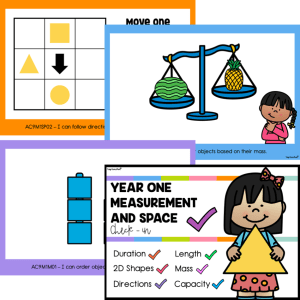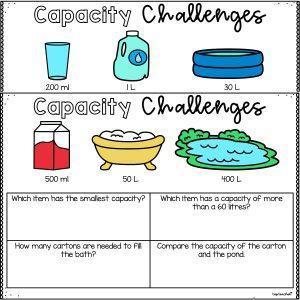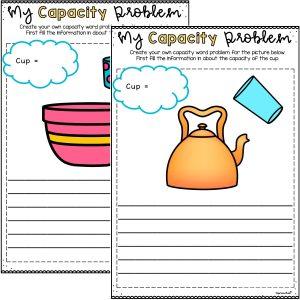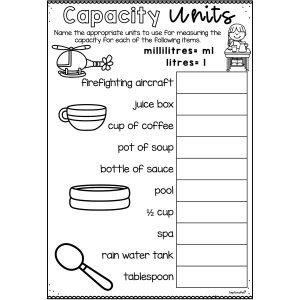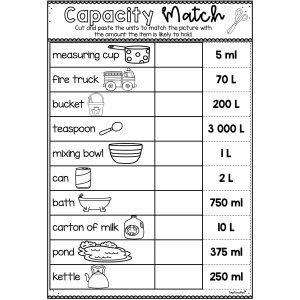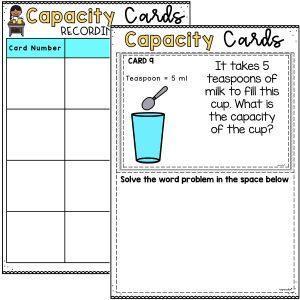Capacity Comparison

Description
Get hands-on with measurement in a fun and meaningful way using our Capacity Comparison activity! This practical task invites students to explore, experiment, and think critically as they pour, measure, and compare the capacities of different containers.
To complete the activity, students will work in pairs to measure the amount of liquid each container holds and then order them from smallest to largest capacity. With the included worksheet, students draw each container and cut out their illustrations to create a sequenced display of capacities – a great visual representation of their learning!
This activity provides an excellent opportunity for your students to engage with informal measurement tools while practising essential skills like estimation, comparison and volume language. It’s the perfect way to build real-world connections and deepen students’ understanding of how capacity can be measured and communicated.
Key Learning Outcomes:
- ✅ Measure and compare the capacities of various containers using informal units
- ✅ Use estimation, pouring and observation to determine capacity
- ✅ Order containers from smallest to largest capacity based on measured results
- ✅ Strengthen fine motor skills through drawing, cutting and gluing
- ✅ Develop collaborative skills through paired discussion and decision-making
What’s Included:
- Student worksheet with space to draw, cut and order containers
- Instructions for completing the task independently or in pairs
- Visual and practical focus to support all learning styles
Materials Needed:
- Printed worksheets (one per student or pair)
- 4 different-sized containers per pair or group
- Measuring cups or jugs (for more accurate comparisons)
- Water and a pouring station (tray or tub recommended for easy cleanup!)
- Pencils, scissors and glue sticks
- Optional: towels or cloths for spills, and write-and-wipe sleeves if reusing worksheets
How to Use:
- Provide each pair or small group with four containers of different sizes
- Have students fill one container at a time and pour into a measuring cup or another container to compare capacity
- Students draw each container at the bottom of their worksheet
- Once all containers have been measured, students cut out their drawings and glue them in order from smallest to largest capacity
- Encourage class discussion or sharing to reflect on surprising results or measurement strategies
Ideas for Classroom Use:
- 💡 Set up as a rotating hands-on maths station during your measurement unit
- 💡 Use as a formative assessment to check understanding of capacity concepts
- 💡 Extend learning by asking students to estimate container capacity before testing
- 💡 Encourage students to use mathematical vocabulary (holds more, holds less, full, empty, estimate, measure)
- 💡 Follow up with a class bar graph comparing which containers held the most or least
Top Teacher Tips:
- 💛 Choose containers of different shapes as well as sizes to prompt discussion about why appearance can be misleading
- 💛 Pre-label each container with a number or letter to help students keep track during testing
- 💛 Complete the task outdoors or in a wet area to reduce spills and cleanup time
- 💛 Encourage students to take photos of their final ordered containers as a visual record of learning
Capacity Comparison is a fantastic way to make volume and measurement learning active and student-led – supporting critical thinking, maths talk and hands-on discovery in your classroom.
Additional information
| Australian Curriculum Code | AC9M1M01, AC9M1M02, AC9M2M01 |
|---|---|
| File Format |
Australian Curriculum V9
F - 6
Lorem ipsum dolor sit amet, consectetur adipiscing elit.
Lorem ipsum dolor sit amet, consectetur adipiscing elit.
Lorem ipsum/ Lorem ipsum/ Lorem ipsum
Lorem ipsum dolor sit amet, consectetur adipiscing elit.
Lorem ipsum dolor sit amet, consectetur adipiscing elit.
Lorem ipsum/ Lorem ipsum/ Lorem ipsum
Lorem ipsum dolor sit amet, consectetur adipiscing elit.
Lorem ipsum dolor sit amet, consectetur adipiscing elit.
Lorem ipsum/ Lorem ipsum/ Lorem ipsum
Lorem ipsum dolor sit amet, consectetur adipiscing elit.
Lorem ipsum dolor sit amet, consectetur adipiscing elit.
Lorem ipsum/ Lorem ipsum/ Lorem ipsum
Lorem ipsum dolor sit amet, consectetur adipiscing elit.
Lorem ipsum dolor sit amet, consectetur adipiscing elit.
Lorem ipsum/ Lorem ipsum/ Lorem ipsum
